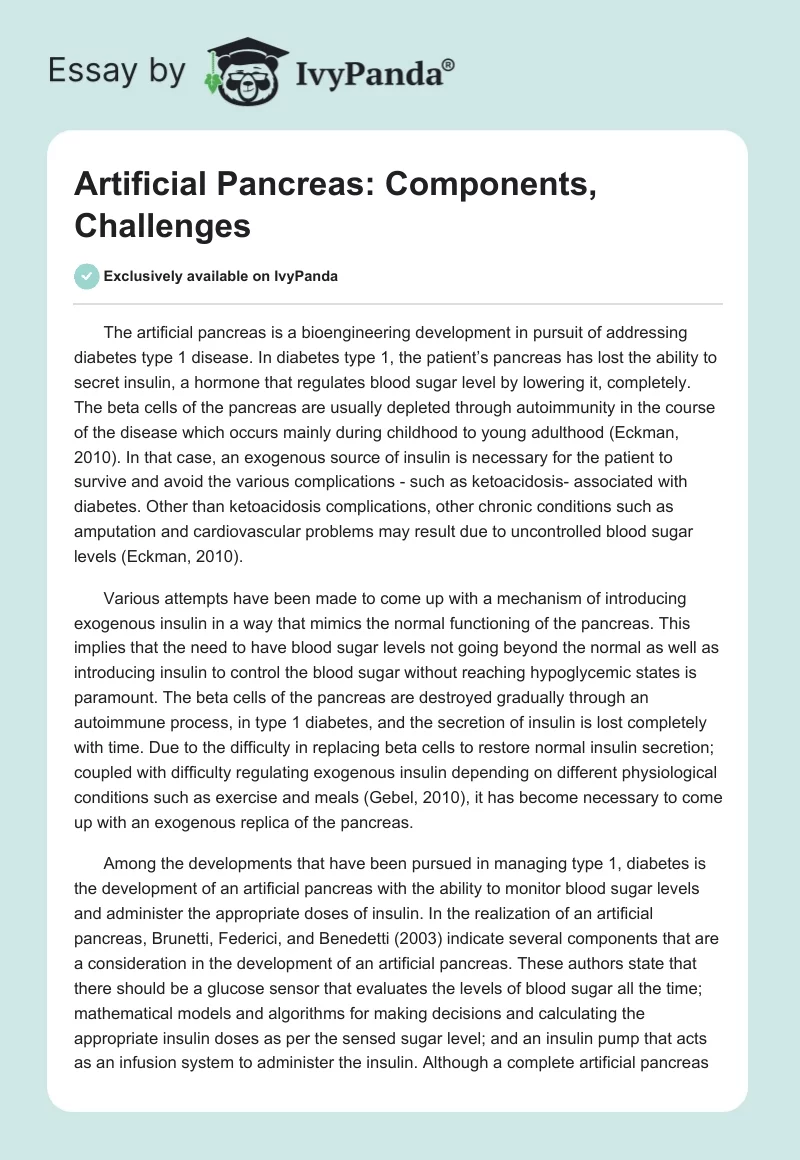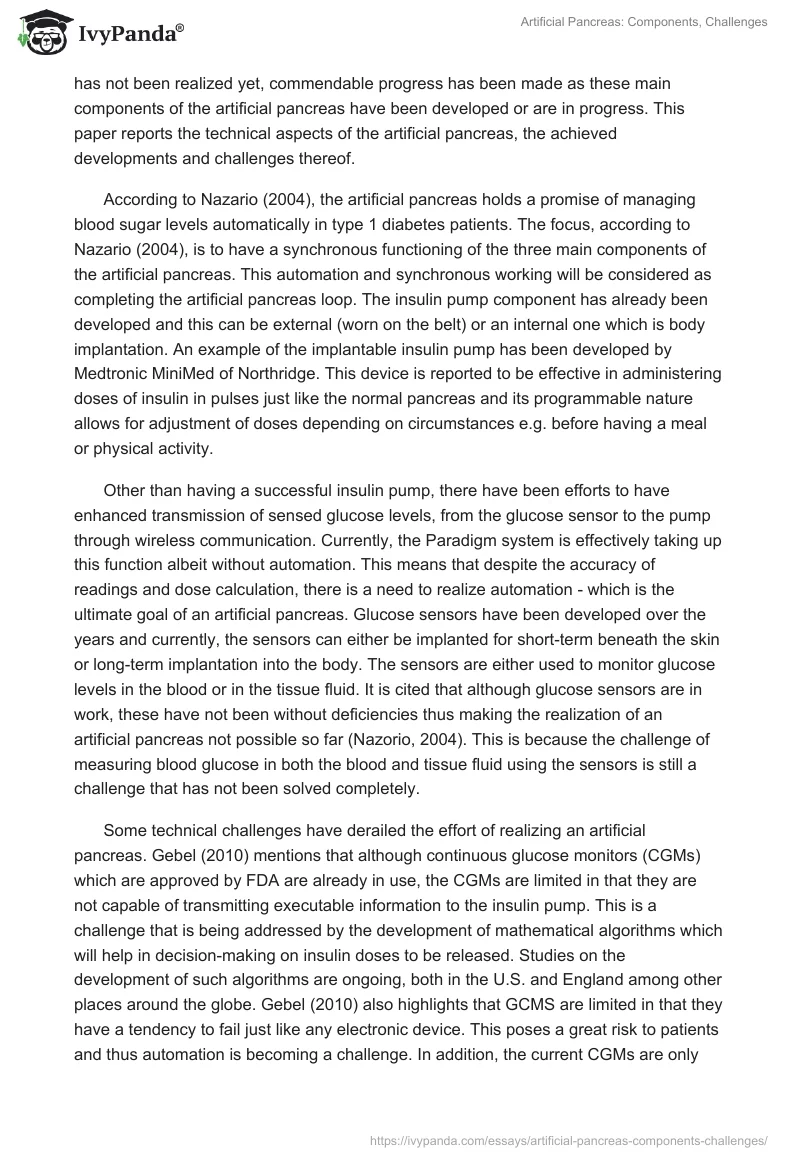The artificial pancreas is a bioengineering development in pursuit of addressing diabetes type 1 disease. In diabetes type 1, the patient’s pancreas has lost the ability to secret insulin, a hormone that regulates blood sugar level by lowering it, completely. The beta cells of the pancreas are usually depleted through autoimmunity in the course of the disease which occurs mainly during childhood to young adulthood (Eckman, 2010). In that case, an exogenous source of insulin is necessary for the patient to survive and avoid the various complications – such as ketoacidosis- associated with diabetes. Other than ketoacidosis complications, other chronic conditions such as amputation and cardiovascular problems may result due to uncontrolled blood sugar levels (Eckman, 2010).
Various attempts have been made to come up with a mechanism of introducing exogenous insulin in a way that mimics the normal functioning of the pancreas. This implies that the need to have blood sugar levels not going beyond the normal as well as introducing insulin to control the blood sugar without reaching hypoglycemic states is paramount. The beta cells of the pancreas are destroyed gradually through an autoimmune process, in type 1 diabetes, and the secretion of insulin is lost completely with time. Due to the difficulty in replacing beta cells to restore normal insulin secretion; coupled with difficulty regulating exogenous insulin depending on different physiological conditions such as exercise and meals (Gebel, 2010), it has become necessary to come up with an exogenous replica of the pancreas.
Among the developments that have been pursued in managing type 1, diabetes is the development of an artificial pancreas with the ability to monitor blood sugar levels and administer the appropriate doses of insulin. In the realization of an artificial pancreas, Brunetti, Federici, and Benedetti (2003) indicate several components that are a consideration in the development of an artificial pancreas. These authors state that there should be a glucose sensor that evaluates the levels of blood sugar all the time; mathematical models and algorithms for making decisions and calculating the appropriate insulin doses as per the sensed sugar level; and an insulin pump that acts as an infusion system to administer the insulin. Although a complete artificial pancreas has not been realized yet, commendable progress has been made as these main components of the artificial pancreas have been developed or are in progress. This paper reports the technical aspects of the artificial pancreas, the achieved developments and challenges thereof.
According to Nazario (2004), the artificial pancreas holds a promise of managing blood sugar levels automatically in type 1 diabetes patients. The focus, according to Nazario (2004), is to have a synchronous functioning of the three main components of the artificial pancreas. This automation and synchronous working will be considered as completing the artificial pancreas loop. The insulin pump component has already been developed and this can be external (worn on the belt) or an internal one which is body implantation. An example of the implantable insulin pump has been developed by Medtronic MiniMed of Northridge. This device is reported to be effective in administering doses of insulin in pulses just like the normal pancreas and its programmable nature allows for adjustment of doses depending on circumstances e.g. before having a meal or physical activity.
Other than having a successful insulin pump, there have been efforts to have enhanced transmission of sensed glucose levels, from the glucose sensor to the pump through wireless communication. Currently, the Paradigm system is effectively taking up this function albeit without automation. This means that despite the accuracy of readings and dose calculation, there is a need to realize automation – which is the ultimate goal of an artificial pancreas. Glucose sensors have been developed over the years and currently, the sensors can either be implanted for short-term beneath the skin or long-term implantation into the body. The sensors are either used to monitor glucose levels in the blood or in the tissue fluid. It is cited that although glucose sensors are in work, these have not been without deficiencies thus making the realization of an artificial pancreas not possible so far (Nazorio, 2004). This is because the challenge of measuring blood glucose in both the blood and tissue fluid using the sensors is still a challenge that has not been solved completely.
Some technical challenges have derailed the effort of realizing an artificial pancreas. Gebel (2010) mentions that although continuous glucose monitors (CGMs) which are approved by FDA are already in use, the CGMs are limited in that they are not capable of transmitting executable information to the insulin pump. This is a challenge that is being addressed by the development of mathematical algorithms which will help in decision-making on insulin doses to be released. Studies on the development of such algorithms are ongoing, both in the U.S. and England among other places around the globe. Gebel (2010) also highlights that GCMS are limited in that they have a tendency to fail just like any electronic device. This poses a great risk to patients and thus automation is becoming a challenge. In addition, the current CGMs are only capable of reading glucose levels in the interstitial fluid only and not in the blood. This is a challenge since glucose levels in interstitial fluid are usually detectable 8 to 10 later compared to blood levels. Another challenge in the development of an artificial pancreas is the fact that current insulin pumps release the insulin into skin tissue and not directly into the bloodstream. This leads to a delay in the regulation of blood glucose and it may not solve spikes in glucose after meals as the normal pancreas does. Overcoming such a hurdle will be a step forward towards realizing an artificial pancreas.
A promising aspect of the development of the artificial pancreas is the fact that the development of algorithms will make it possible to have the right doses of insulin being released. This will ultimately resolve the main challenge of determining the right dose, which in many cases has caused hypoglycemia due to excessive insulin release (Wadman, 2008). One of the aspects of the algorithm that is still under development is a shut-off system that will act as a safety layer to prevent further release of insulin when glucose levels go very low. According to JDRF (2010), the artificial ought to be tested in the real world now to determine its success and safety. There is hope that in the future, different algorithms will be available to address the needs of different types of patients like the pregnant, physically active or teens (Gebel, 2010).
The aspect of biocompatibility in the development of an artificial pancreas has not been ignored. This is because there are prospects of having an implantable device which should function steadily once in the subcutaneous tissue. Uchiyama, Watanabe& Ishihara (2004) describe that insulin-release pumps should be perfectly biocompatible otherwise even the best pump would be rendered of less or even no use as an implantable device. It is reported that some implantable insulin pumps have caused fibrous in-growth in dogs (due to reaction of the tissue to polyurethane) thus faltering the functioning of the pump within two months only. Uchiyama, Watanabe& Ishihara (2004) also report catheter obstruction by fibrin clots among other immuno-inflammatory reactions in type 1 and type 2 diabetes patients. Glucose sensors are also supposed to show biocompatibility if they are to function accurately over a long time. However, bio-fouling has been suspected to occur at the sensor surface leading to reduced sensitivity during the implantation period (Uchiyama, Watanabe & Ishiara, 2004). The encouraging aspect however is that the levonogestrol sustained release system is being explored as a biocompatible reservoir for insulin. This is expected to resolve biocompatibility as well as eliminate the use of most insulin pumps which are made of metal parts. The metal parts are disadvantageous in that they not only occupy a large space but they are also heavy and therefore problematic to implant (Uchiyama, Watanabe& Ishihara, 2004). Polymer-alloy membranes therefore present as suitable biocompatible alternatives (Park & Song, 2005).
Despite there being a lot of hope in coming up with an artificial pancreas, it is acknowledged that it may take time and enormous research. The good news, however, is that each effort is adding up to the already existing knowledge and improvements on already existing precursors of artificial pancreas are encouraging. Moreover, the willingness of researchers, pharmaceutical and research companies such as the FDA, Medtronic Diabetes, Animas Corp., and UCSB (Gebel, 2010) among others to participate in the development of an automated and fully functional artificial pancreas is good news to type 1 diabetes patients. These patients will not keep worrying on monitoring the blood sugar levels. For type I diabetes patients, an artificial pancreas will save them from worry as everything will be under control. There is however need to realize the artificial pancreas as soon as possible and not to make it a promise which will take years to come and therefore not benefit most patients now. The artificial pancreas is definitely going to serve type 1 diabetes patients as they await the discovery of the real cure for the disease.
List of References
Brunetti, P., Federici, M. O. and Benedetti, M. M., 2003. The artificial pancreas. Artificial Cells, Blood Substitutes, and Biotechnology, 31(2), 127-138.
Eckman, A. S., 2010. Type 1 diabetes. Web.
Gebel, E., 2010. The artificial pancreas: Scientists race to make the closed-loop glucose management system a reality. Diabetes Forecast. Web.
JDRF., 2010. JDRF Clinical Panel recommends next steps for artificial pancreas clinical testing. Web.
Nazario, B., 2004. Artificial pancreas on the horizon. MedicineNet.com. Web.
Park, K. -H. and Song, S. -C., 2005. A thermo-sensitive poly(organophosphazene) hydrogel used as an extracellular matrix for artificial pancreas. J. Biomater. Sci. Polymer Edn, 16(11): 1421–1431.
Uchiyama, T., Watanabe, J. and Ishihara, K., 2004. Implantable polymeric artificial pancreas. J. Biomater. Sci. Polymer Edn, 15(10): 1237–1262.
Wadman, M., 2008. Success of blood-sugar monitors puts artificial pancreas in reach. Nature Medicine, 14(10):994.


